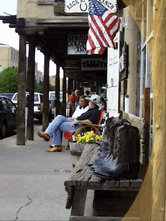Around La Plaza
Palace of the Governors
Santa Fe's old central plaza is still the focus of town life, especially during the annual Indian Market on the weekend after the third Thursday in August, when buyers and craftspeople come from all over the world, and during the Labor Day weekend for the Fiestas de Santa Fe.

Apart
from an influx of art galleries and stylish restaurants, the
web of narrow streets around the plaza has changed little through
the centuries. When the Yankees took over in 1848, they neglected
the adobes and chose instead to build in wood, but many of the finer
adobe houses have survived, thanks in part to a 1930s preservation
campaign. Since then almost every non-adobe structure within sight
of the plaza, even the downtown Woolworth's, has been
designed or redecorated to suit the city-mandated Spanish Revival
mode, with oddly sloping, rounded, mud-colored plaster walls
supporting roof beams made of thick pine logs (called vigas).
Santa Fe today, in fact – at least at its core – looks much more
like its original Spanish self than it did a hundred years ago.
The main focus of the plaza, and the principal model for Santa
Fe's revived architectural unity, is the Palace of the Governors,
which fills its entire northern side. Part of the Museum of New
Mexico, this low-slung and initially unprepossessing structure is
actually the oldest public building in the US. Originally
sod-roofed, it was constructed in 1610 as the headquarters of
Spanish colonial administration; the name may now seem misleadingly
grand, but the building was once much larger. The well-preserved
interior, organized around an open-air courtyard, holds excellent
displays on New Mexico's history, plus photos that show that until
1913 the palace itself looked like a typical, formal, territorial
building, with a square tower at each corner. Its subsequent adobe
"reconstruction" was based on pure conjecture. The arcaded
adobe veranda along its front, offering protection from both sun and
wind, serves as a market for local Native American crafts-sellers. Just west of the palace, the Museum of Fine Arts is housed
in a particularly attractive adobe, with ornamental beams and a cool
central courtyard. It's also one of the few major art museums to be
established by artists, as opposed to educators or collectors, and
focuses on changing exhibits of contemporary painting and sculpture
by mostly local artists. The showpiece new Georgia O'Keeffe
Museum, a block northwest at 217 Johnson St, opened in 1997,
with ten galleries housing the largest collection of O'Keeffe's work
in the world. Pieces range in date from 1914 – thus pre-dating her
exposure to New Mexico, though a 1915 rendition of Palo Duro Canyon
in Texas hints at the abstractions to come – up to 1982. Among the
sun-bleached skulls and iconic flowers sold in print galleries
throughout the Southwest, some less familiar New York cityscapes
make a surprising contrast. Most of the desert landscapes were
painted near Abiquiu, forty miles northwest of Santa Fe,
where O'Keeffe lived from 1946 until her death in 1986. Across the tiny Santa Fe River to the southwest, three blocks
along Guadalupe Street, you'll find a less celebrated but equally
attractive little district, centered around the small but beautiful Santuario
de Guadalupe (May–Oct Mon–Sat 9am–4pm; Nov–April
Mon–Fri 9am–4pm; donation). Complete with a fine Baroque reredos
(altarpiece), the shrine was built at the end of the eighteenth
century to mark the end of the Camino Real highway from
Mexico City. Old warehouses and small factory premises nearby, such
as the Sanbusco Centre on Montezuma Avenue, have been
converted to house boutiques, art galleries and restaurants. Follow the river upstream, or walk two blocks east from the
plaza, and you approach a building, strangely out of place among
Santa Fe's earthy adobes, looming at the top of San Francisco
Street. St Francis Cathedral, the first church west of the
Mississippi to be designated a cathedral, was built in 1869 by Archbishop
Lamy. French-educated Lamy, the title figure in Willa Cather's
novel Death Comes for the Archbishop, commissioned the
building in the formal – and, frankly, dreary – Romanesque style
popular in France. The nearby Loretto Chapel, a block away at
the start of Old Santa Fe Trail, is known for its so-called
"Miraculous Staircase", an elegant spiral built without
nails or obvious means of support. During construction, the church's
designer is said to have been killed by Lamy's cousin, so that for
years there was no way up to the choir loft. According to legend, an
unknown carpenter arrived in answer to the nuns' prayers, built the
stairs and then disappeared. Two blocks south, across the river along the Old Santa Fe Trail,
is the ancient San Miguel Mission (Mon–Sat 10am–4pm, Sun
2–4.30pm). Only a few of the massive adobe internal walls survive
from the original 1610 building, most of which was destroyed in the
1680 Pueblo Revolt. The chapel is the heart of the old Barrio de
Analco workers' district, whose many two-hundred-year-old houses
now form one of Santa Fe's most appealing residential neighborhoods. Not far away to the east, gallery-lined Canyon Road –
which stakes a claim to being the oldest street in the US, dating
from Pueblo days – climbs a steady but shallow incline along the
river bed and is lined by dozens of fine adobes.



